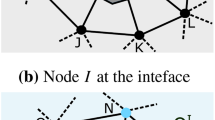Abstract
This paper describes a strategy to solve multi-fluid and fluid–structure interaction (FSI) problems using Lagrangian particles combined with a fixed finite element (FE) mesh. Our approach is an extension of the fluid-only PFEM-2 (Idelsohn et al., Eng Comput 30(2):2–2, 2013; Idelsohn et al., J Numer Methods Fluids, 2014) which uses explicit integration over the streamlines to improve accuracy. As a result, the convective term does not appear in the set of equations solved on the fixed mesh. Enrichments in the pressure field are used to improve the description of the interface between phases.



















Similar content being viewed by others
References
Ausas RF, Buscaglia GC, Idelsohn SR (2012) A new enrichment space for the treatment of discontinuous pressures in multi-fluid flows. Int J Numer Method Fluids 70(7):829–850
Belytschko T, Liu WK, Moran B, Elkhodary K (2013) Nonlinear finite elements for continua and structures. Wiley, New York
Brumley DR, Willcox M, Sader JE (2010) Oscillation of cylinders of rectangular cross section immersed in fluid. Phys Fluids 22(5):052,001 (1994-present)
Codina R (2000) Stabilization of incompressibility and convection through orthogonal sub-scales in finite element methods. Comput Method Appl Mech 190(13):1579–1599
Codina R, Badia S (2006) On some pressure segregation methods of fractional-step type for the finite element approximation of incompressible flow problems. Comput Method Appl Mech 195(23):2900–2918
Coppola H (2009) A finite element model for free surface and two fluid flows on fixed meshes. Ph.D. thesis, Universitat Politècnica de Catalunya
Dadvand P, Rossi R, Oñate E (2010) An object-oriented environment for developing finite element codes for multi-disciplinary applications. Arch Comput Method Eng 17(3):253–297
DeBlois BM (1997) Linearizing convection terms in the Navier–Stokes equations. Comput Method Appl Mech 143(3):289–297
Donea J, Huerta H (2003) Finite element methods for flow problems. Wiley, New York
Felippa CA (2004) Introduction to finite element methods. University of Colorado, Boulder. http://www.colorado.edu/engineering/CAS/courses.d/IFEM.d
Guermond JL, Quartapelle L (2000) A projection fem for variable density incompressible flows. J Comput Phys 165(1):167–188
He X, Chen S, Zhang R (1999) A lattice boltzmann scheme for incompressible multiphase flow and its application in simulation of rayleigh-taylor instability. J Comput Phys 152(2):642–663
Idelsohn S, Nigro N, Gimenez J, Rossi R, Marti J (2013) A fast and accurate method to solve the incompressible Navier–Stokes equations. Eng Comput 30(2):2–2
Idelsohn SR, Marti J, Becker P, Oñate E (2014) Analysis of multifluid flows with large time steps using the particle finite element method. Int J Numer Methods Fluids
Idelsohn SR, Marti J, Limache A, Oñate E (2008) Unified lagrangian formulation for elastic solids and incompressible fluids: application to fluid–structure interaction problems via the pfem. Comput Methods Appl Mech 197(19):1762–1776
Oñate E, Franci A, Carbonell JM (2014) Lagrangian formulation for finite element analysis of quasi-incompressible fluids with reduced mass losses. Int J Numer Methods Fluids 74(10):699–731
Oñate E, Franci A, Carbonell JM (2014) A particle finite element method for analysis of industrial forming processes. Comput Mech 54:1–23
Tezduyar TE (1992) Stabilized finite element formulations for incompressible flow computations. Adv Appl Mech 28:1–44
Turek S, Hron J (2006) Proposal for numerical benchmarking of fluid–structure interaction between an elastic object and laminar incompressible flow. Springer, Berlin
Van Eysden CA, Sader JE (2006) Resonant frequencies of a rectangular cantilever beam immersed in a fluid. J Appl Phys 100(11):114,916
Wendland H (1995) Piecewise polynomial, positive definite and compactly supported radial functions of minimal degree. Adv Comput Math 4(1):389–396
Zienkiewicz O, Taylor R, Zhu JZ (2006) The finite element method: its basic and fundamentals, vol 1, 6th edn. Elsevier, New York
Acknowledgments
This research has been partly funded by the People Programme (Marie Curie Actions) of the European Union’s Seventh Framework Programme FP7/2007-2013/ under REA Grant agreement no. 289911. This work was also supported by the ERC Advanced Grant REALTIME Project (AdG-2009325), the ERC Advanced Grant SAFECON Project (AdG-26752) and the HFLUIDS Project of the National RTD Plan of the Spanish Ministry of Science and Innovation (BIA2010-15880). The authors would also like to thank Dr. Riccardo Rossi for suggesting the special shape functions used in this work.
Author information
Authors and Affiliations
Corresponding author
Rights and permissions
About this article
Cite this article
Becker, P., Idelsohn, S.R. & Oñate, E. A unified monolithic approach for multi-fluid flows and fluid–structure interaction using the Particle Finite Element Method with fixed mesh. Comput Mech 55, 1091–1104 (2015). https://doi.org/10.1007/s00466-014-1107-0
Received:
Accepted:
Published:
Issue Date:
DOI: https://doi.org/10.1007/s00466-014-1107-0



